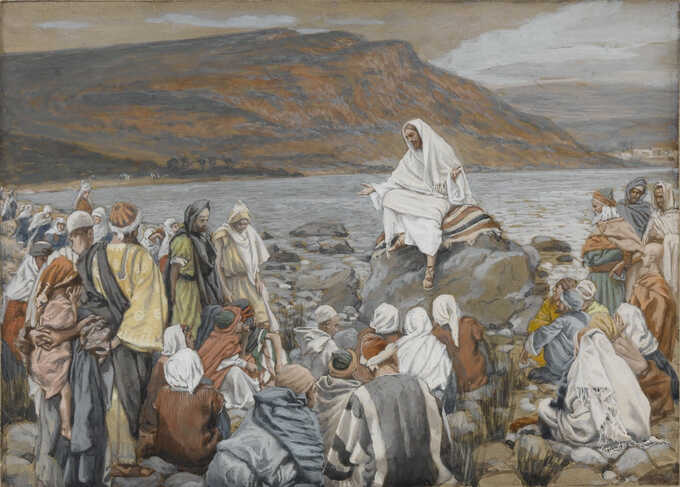
The story of Jesus 1 is an important one, not least because it weaves together two narratives to create a richly textured drama which for many answers some of life's most difficult questions. Why am I here? Where am I going? One narrative concerns the historical Jesus. Jesus is an ordinary corporeal person who walks on land, eats broiled fish, and dies. The second narrative concerns a theological Jesus. He walks on water, multiplies fish, and resurrects.
Herein, I reflect on the historical Jesus without any imputed divine attribute. I offer mundane interpretations of some of the fantastical incidents involving Jesus. Such incidents include his alleged virgin birth by Mary, Jesus walking on water in the Sea of Galilee, his resurrection following crucifixion, and his ascension.
I declare this essay to be my own work, arising from my own reading and analysis. Errors and inaccuracies are my own. And thank you, Mels, for your critical proofreading.
I dedicate this to my dad, Paul Herbert Kotschy (1933–2019). He taught me that it is nice to know things, and that perhaps the greatest value of knowledge is not that it enables things to get done, but rather that it offers enlightenment and informs context.
Non-biblical archaeological records
of the life and times of Jesus are scant. Flavius Josephus'
Antiquities of the Jews[2]
gives two short accounts of Jesus.2
The first account is problematic. Although
considered to contain some truths, it was
interpolated and/or altered by later church
scribes.[4]
The second account mentions Jesus in passing, as
being the brother of James. It is intriguing that
a Jewish writer who is not a Christian would refer
to Jesus as Christ.3
The Roman historian Tacitus
(56–117 ce),
in his
Annals[6]
which was probably written around 70 to 80 years
after Jesus, refers to Jesus as the Christus
.4
Tacitus gives no indication that he knows anything
about the beliefs of the Christians, and much less
about the life or teachings of Jesus himself.
The canonical Gospel of Mark is considered by most biblical scholars to have been written around 70 ce, at the time of the siege of Jerusalem during the First Jewish-Roman War.[8] And the Gospels of Matthew and Luke are thought to have been written either at the same time as Mark or about fifteen years later (85 ce). [9]
Herein, I reflect on Jesus as an ordinary man, without having divine attribute. I try to offer explanations of some of the fantastical or allegorical:; stories in the gospels involving Jesus. My explanations will identify possible poetic embellishment by the gospel writers. Of course, my explanations come with uncertainty and with some interpolation, as do all. But in the face of uncertainty, we are obliged to ask which explanations plausibly account for most of what we do know about the real Jesus.
I am convinced that
Jesus did walk upon our good Earth. I think he was
a good man, although not perfect. Indeed, the very
notion of perfect
is dubious. For instance,
what does sinless mean? If we accept that Jesus was
in fact human—a living and breathing corporeal
person made of stuff organic—then which
psychological traits and bodily functions
did Jesus not share with the rest of us?
Was Jesus ever naughty as a young boy, or recalcitrant as a teenager? Was Jesus ever unfair to his brothers in small or big ways. Did he have any ego which sometimes got in the way of better judgement? Was Jesus lazy at times? Did he swat insects wantonly? Did Jesus ever have any erotic thoughts? Did his mood fluctuate in step with his circadian rhythm, as does mine? Was he ever imperious towards his disciples?
Thinking like this may seem sacrilegious to some. But a God incarnate should withstand such scrutiny if indeed he is incarnate. If Jesus was a real man as claimed, then it helps to imagine him as a real man, just like it helps to imagine Flavius Josephus, Caesar Vespasian, John Doe, Nelson Mandela, and my younger brother as real men.
I think Jesus was born of his mother by natural birth and by natural conception. I most certainly do not believe that Mary was a virgin. She must have had sexual relations during the year of erusin, which was a 1-year period of separate betrothal prior to nissuin (marriage) in accordance with ancient Jewish custom. The inconsistent accounts in Matthew 1:18--25 and Luke 1:26--38 of there being an angel and of Mary falling pregnant without sexual intercourse are both literary devices to make the occasion of the birth of Jesus seem auspicious. Curiously, there have been many claims of virgin births through history.5 And I don't believe Mary was a virgin just as much as I don't believe the other accounts either.
The Gospel of Luke uses the statewide Census of Quirinius as a narrative means to establish the birth of Jesus in Bethlehem (Luke 2:1-5). But the Gospel of Matthew places Jesus' birth within the reign of Herod the Great, who had died nine years earlier (Matthew 2). Luke needed the census to give the birth of Jesus a solemn setting and to explain what Mary and Joseph were doing in Bethlehem. Luke believed they were living in Nazereth. Conversely, the author of the Gospel of Matthew pictured Mary and Joseph living in Bethlehem, and he had to explain why they moved to Nazereth (Matthew 2:22-23). Most critical scholars think the Gospel of Luke is in error.[11] The error is a crucial one because it concerns events around the time of Jesus' birth, itself a crucial event in Christian theology.
Since there was no such census at the time of Jesus' birth, Joseph could not have gone to his hometown Bethlehem for the census. Why then make the long trip on foot? Possibly to protect Mary from the ignominy of falling pregnant during the period of erusin. The chosen birthplace was intentionally discreet because Mary and Joseph feared for the life of their illegitimate child.
During middle Classical Antiquity, there were many Greek city-states in Galilee. Some had been strategically placed along the Jordan River by the Seleucids.[12] Growing up in Egypt and Galilee, Jesus would therefore have been exposed to Hellenistic, Roman and Egyptian influences. This includes not only insular Jewish culture and Judaic religious tradition, but also Greek culture, Roman culture, Roman politics, and Greek, Roman and Egyptian pagan mythology[13][14][15][16] which were popular in the region during middle Classical Antiquity.67
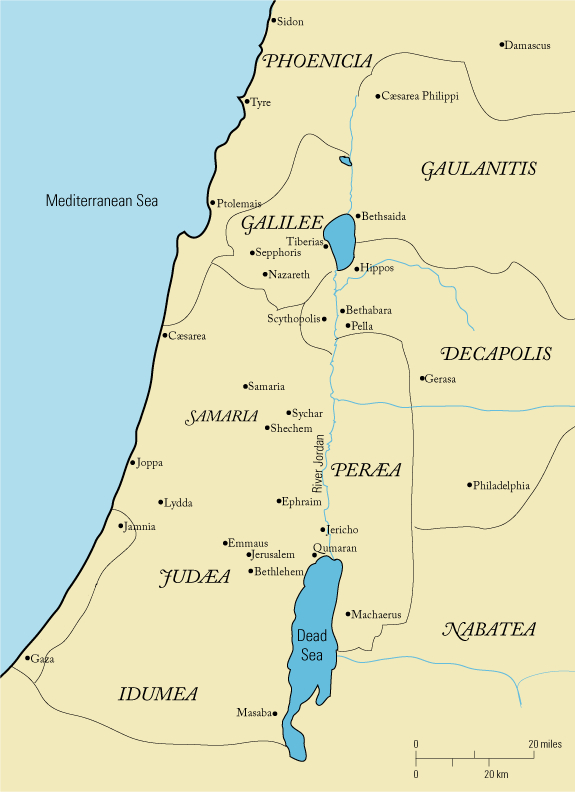
The Near East was thus both a social and cultural melting pot and a rich and diverse mythological ecosystem. This, combined with Jesus' obvious empathy and compassion for ordinary folk meant that he must have been frustrated by the pious ethos of the Jewish orthodox establishment centred at the Second Temple in Jerusalem. Simply put, as a Hellenistic Jew, Jesus espoused an inclusive social message centred on a mythology located more or less midway between the austerity of Judaic monotheism and the inclusivity of Hellenistic paganism. Jesus was the embodiment of the people of his time and place.
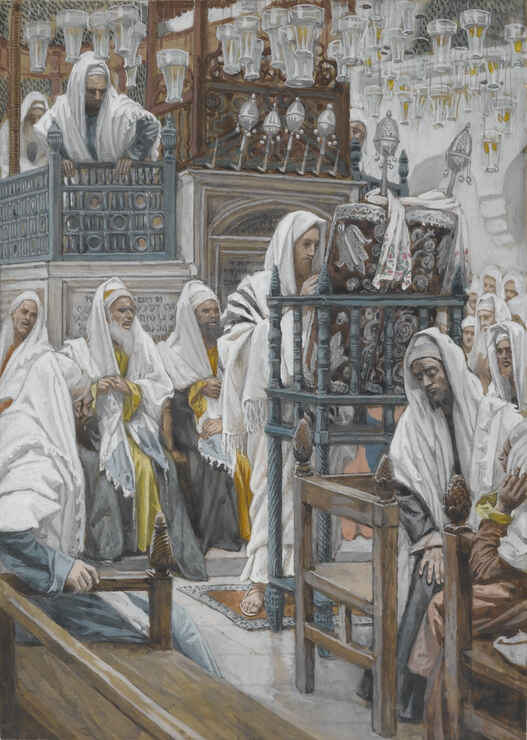
I do not believe Jesus performed any incontrovertible miracles. For some miracles recorded in the Bible, plausible non-fantastical explanations are available, reflecting possible embellishment by the ancient theologically oriented writers. One such event is Jesus walking on water.
The event of Jesus walking on water at Bethsaida on the Sea of Galilee is recorded in Mark 6:45--52, Matthew 14:22--34, John 6:15--21. As an itinerant preacher during his ministry years, Jesus would have spent much time in Galilee visiting coastal towns such as Gennesaret, Capernaum and Bethsaida, preaching on the lake's shores. Capernaum, for example, is about 4 km (2.5 miles) from Bethsaida, and there was a synagogue in Capernaum where Jesus often preached (Mark 5:22, Luke 7:5).
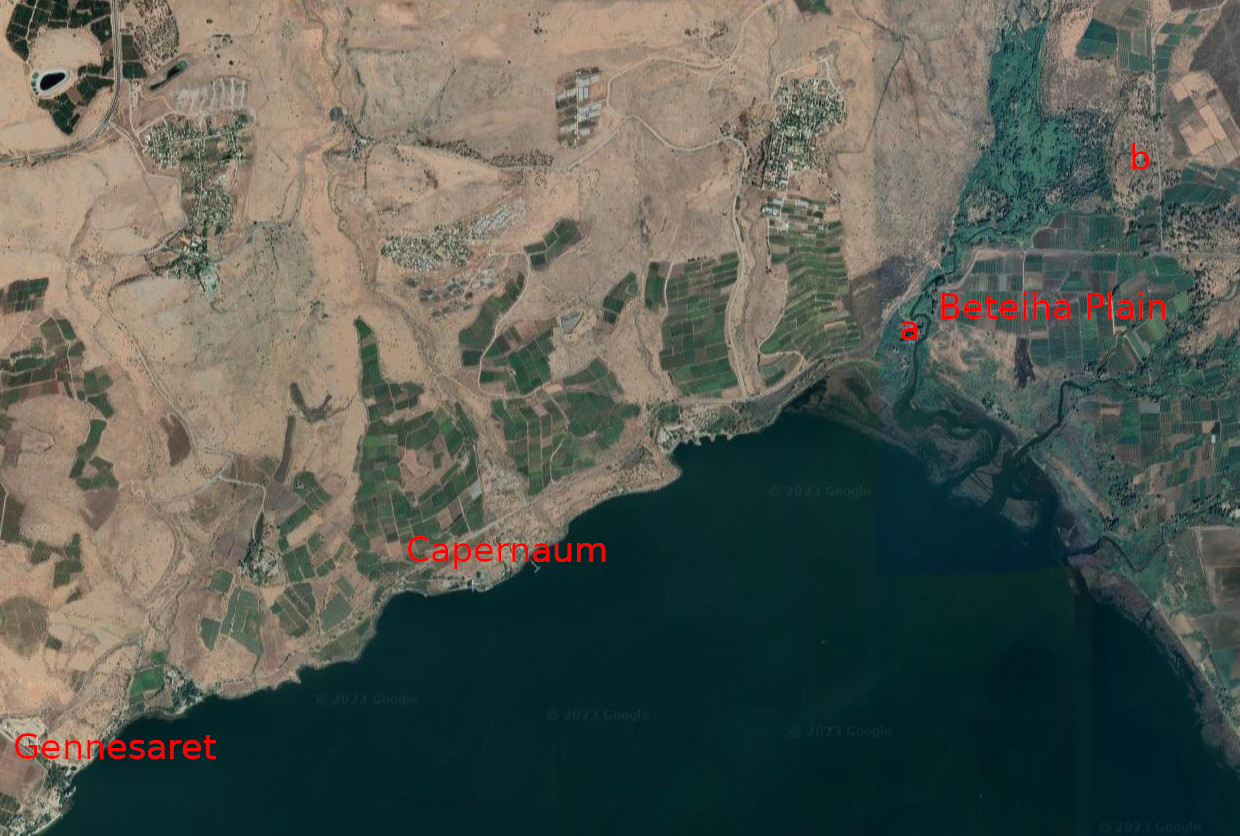
What possible natural sequence of events could have transpired after his disciples climbed into their boat and began rowing to Bethsaida, such that the sequence ultimately came to be mythologised and immortalised by later religious scribes as the Jesus-walking-on-water miracle? Knowledge of the relative location of Bethsaida during Jesus' time, of the topography near to the disciples' intended destination (Bethsaida), and of the flow characteristics of the Jordan river offer valuable insights. And it is these insights which offer such a natural sequence of events.
A extensive sedimentologic and geomorphic survey of the western part of the Beteiha Plain was carried out and reported on in 2000.[24] The study concluded that an inlet, bay or estuary existed at or near the ancient Bethsaida town not unlike the present-day estuary where the Jordan river empties into the Sea of Galilee. The study also concluded that strong seasonal flash flooding of the Jordan river occurred.
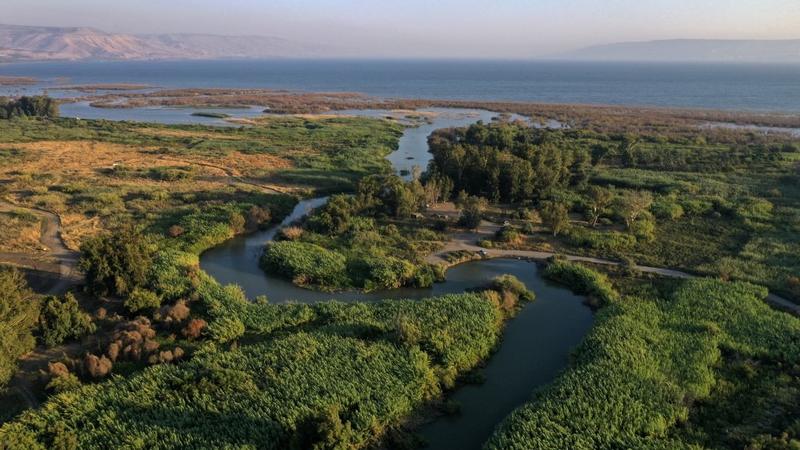
Therefore, knowing: 1. that the disciples were not far from Bethsaida when they initially climbed into their boat and began rowing, 2. the topography of the Beteiha Plain in antiquity, 3. that there was an inlet or estuary system near Bethsaida in antiquity, 4. that the Jordan river undergoes flash flooding from time to time, and 5. that the disciples were indeed trying to make their way to Bethsaida by boat, we are able to reconstruct the following plausible sequence of events:
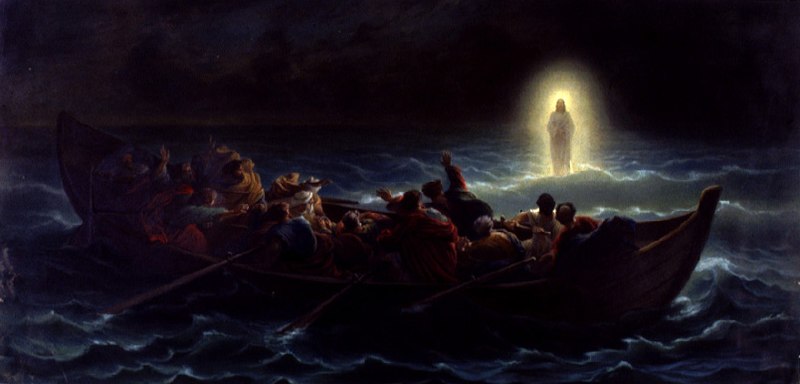
A crucifixion event occurred in Jerusalem.
Like so many people who for one reason or another fell foul of the law, Jesus was subjected to inscrutable suffering: sourging, ignominy, isolation, rejection, and ultimately crucifixion. After carrying a heavy patibulum from Pilate's Praetorium to Golgotha, the patibulum was fastened to the stipes, forming a cross. He was nailed to it by hands and feet. Contemplating his ordeal stirs an ineffable sadness. But he might well have survived!
A number of clues suggest that Jesus survived the crucifixion. Careful reading of the biblical texts reveals these clues. They will be presented shortly. But first, I present my reconstruction of how and why Jesus could reasonably have survived. My reconstruction here is based on a straightforward reading of the biblical texts, with a minimum of embellishment. Indeed, far less embellishment than is required when reading in Matthew 27:52,53 about burial tombs in Jerusalem opening and the dead rising and walking around amongst the living.
My case for Jesus' likely survival is supported in part by the disposition of two influential men, namely, Pontius Pilate and Joseph of Arimathea. Pilate and Joseph shared a sympathy for Jesus. Pilate's sympathy led to his uncooperativeness in the judicial process. And Joseph's sympathy led to him caring for Jesus after the crucifixion.
From his judicial position as the Roman Prefect of the province of Judaea, Pontius Pilate was impressed by Jesus and could not find sufficient grounds to sentence him to death. In fact, we know that Pilate had planned to punish Jesus and then release him. And with the help of Joseph, Pilate carried out his plan without overtly betraying the Jewish Sanhedrin.
Joseph was rich, influential, and a member of the Sanhedrin council (Matthew 27:57, Luke 23:50--56). And being sympathetic to Jesus, he had not consented to the council's decision and actions to have Jesus killed. So we can be quite sure that Joseph and Pilate knew each other and would have discussed how best to deal with Jesus, each from their own cooperative vantage point.
Of the three condemned to be crucified at Golgotha, Jesus was the only one to not have his legs broken. This enabled him to breathe. And importantly, it allowed Jesus to walk soon afterwards. So taking Pilate's sympathy and role into account, together with the wishes of the Sanhedrin for a speedy execution, I find it difficult to see how Pilate could not have played a role in ensuring that Jesus' legs were not broken. See below for further discussion on this.
Jesus was taken down from the cross surprisingly early after only a few hours, still alive. He was still alive, inasmuch as his two fellow victims were recorded as being still alive at the time. He was then moved to Joseph's private house, initially placed in an above-ground tomb on Joseph's private property, away from public scrutiny. This was carried out hurriedly for the Sabbath was nigh.
At least for the first night and possibly for longer the tomb was not secured with any Roman policing presence. So after a few hours, under cover of darkness and with the onset of the Sabbath of the first night, Jesus could easily have been relocated into Joseph's house or to some other secure and hidden location. And when any guards arrived the next day, if at all, it is quite possible that the tomb was already empty without them knowing.
So when some of the women who were close to Jesus arrived at the tomb after the Sabbath, it was found empty. Jesus was recuperating elsewhere, secluded in Jerusalem and in the care of Joseph of Arimathea and Nicodemus. Having lost consciousness during the crucifixion ordeal and being in a state of extreme shock, possibly even hypovolemic shock,8 Jesus himself might have thought he had died and returned to life.
Jesus then clandestinely made his way back home to Galilee to escape the inimical clutches of conservative religious orthodoxy in Judaea.
Later, he met up with his disciples somewhere in
Galilee, or possibly back in Jerusalem. It was
easy for him to convince his inner circle
that he was the same physical person
as he was before his crucifixion. His body was
ostensibly physical. He showed them his hands and
feet; his wounds were real; he even ate some
broiled fish! And he advised them that his (and
their) mission of promoting social and
religious inclusivity and of heralding a new
Kingdom of God must continue.
Unsurprisingly, because Jesus suffered from post-traumatic stress, he behaved surreptitiously, exactly as I think I would behave. He would arrange to meet his disciples far out of town, such as in the cemetery on Mt Olivet located about 5 km east of Jerusalem, a place where few people go.
But fearing recapture by the Jewish authorities,
he gave a final sermon during one such meeting on
Mt Olivet
He walked further up into the mountains, higher
into the low-hanging mist or clouds, and
disappeared out of view, all while his disciples
were watching. And in this way, Jesus
ascended into Heaven.
(See Section
Jesus the ascended man
below.)
I identify four types of clues hinting at Jesus surviving the crucifixion. They are clues of Inconsistency, clues of Detail, clues of Reliability and clues of Embellishment.
Having spent much of his life in Galilee and Egypt, Jesus was culturally progressive relative to the orthodox Jews living in Judaea. So it's not surprising that in the eyes of the conservative Jewish establishment centred at the Jerusalem temple, Jesus was an iconoclast who threatened their way of life.
Conversely, to the Roman authorities and
Pontius Pilate in particular, Jesus was
not regarded as a political threat.
Indeed, his well-known Render unto Caesar
aphorism
which is attested in the three synoptic gospels
reflects his political progressiveness in relation
to Rome:9
They brought the [denarius] coin, and he asked them,After the Jewish Sanhedrin handed Jesus over to Pilate, he interrogated Jesus. An account is given in Mark, in the gospel's typical laconic style:Whose image is this? And whose inscription?Caesar's,they replied. Then Jesus said to them,Give back to Caesar what is Caesar's and to God what is God's.— Mark 12:16--17 NIV
It seems that Pilate was trying to guage Jesus' sense of Jewish political nationalism, and hence his antipathy towards Roman rule. Following Pilate's subsequent conversations with the chief priests, it is evident that he saw nothing in Jesus that warranted concern:Are you the king of the Jews?asked Pilate.You have said so,Jesus replied. The chief priests accused him of many things. So again Pilate asked him,Aren't you going to answer? See how many things they are accusing you of.— Mark 15:2--4 NIV
So from his judicial position as the Roman Prefect of the province of Judaea, Pilate could not find sufficient political grounds to sentence Jesus death. And so he had to be coerced by the chief priests.Do you want me to release to you the king of the Jews?asked Pilate, knowing it was out of self-interest that the chief priests had handed Jesus over to him. But the chief priests stirred up the crowd to have Pilate release Barabbas instead.What shall I do, then, with the one you call the king of the Jews?Pilate asked them.Crucify him!they shouted. Why? What crime has he committed? asked Pilate. But they shouted all the louder,Crucify him!— Mark 15:9--14 NIV
I find it significant that Pilate's plan all along was to punish Jesus and then to release him. Luke's gospel records that Pilate said:
Neither has Herod [found basis for charging Jesus] for he sent him back to us; as you can see, he has done nothing to deserve death. Therefore, I will punish him and then release him. — Luke 23:16Pilate then restated his plan:
For the third time [Pilate] spoke to them:What would I have done if I was a Pontius Pilate with scruple? For sure, I would have formulated a secret plan to have Jesus' life spared whilst working to honour protocol.Why? What crime has this man committed? I have found in him no grounds for the death penalty. Therefore I will have him punished and then release him.— Luke 23:22
Roman soldiers supervising a crucifixion often resorted to crurifragium—breaking one or both of the bones of the lower limbs (the tibia), and sometimes also the fibula) with a blunt instrument.[28]
According to John 19:31--33 however, Jesus' legs were not broken:
Because the Jewish leaders did not want the bodies left on the crosses during the Sabbath, they asked Pilate to have the legs broken and the bodies taken down. The soldiers therefore came and broke the legs of the first man who had been crucified with Jesus, and then those of the other. But when they came to Jesus and found that he was already dead, they did not break his legs. — John 19:31--33Not breaking Jesus' legs enabled him to breathe. And importantly, it allowed him to walk after a period of recuperation.
John's gospel also records that in the case of Jesus, the Jewish leaders had to ask Pilate to order the deed. This suggests that it was not Pilate's intention to do so. Pilate had other plans.
Is it not odd that the Roman soldiers decided on their own to disobey a direct order from Pilate regarding one of the three men? If they were given such an order from someone as authoritative as Pilate, then surely they would have obeyed the order even if they saw that Jesus was already dead. Are not soldiers trained to obey orders, especially from high up?
Furthermore, Pilate and the Roman soldiers would have known that the Jewish Sanhedrin wanted the crucifixion to be done hurriedly before the Sabbath which began at sundown on Friday. Knowing this would surely have motivated them further to break Jesus' legs to ensure his speedy death.
So given 1. Pilate's authority and sympathy for Jesus, 2. the propensity of soldiers to obey orders, 3. the fact they did break the legs of the other two victims, and 4. the wish of the Sanhedrin for haste, I find it difficult to see how Pilate could not have played a role in ensuring that Jesus' legs were not broken.
vinegar.
John 19:28--30 states:
Later, knowing that everything had now been finished, and so that Scripture would be fulfilled, Jesus said,In Jerusalem, it was customary for the women to offer the victim an analgesic drink consisting of wine and myrrh or incense.[29] This was to help ease the pain and provide a sense of detachment. The drink could also have included some sort of anaesthetic drug to render him temporarily unconscious, thereby appearing dead to the onlookers.I am thirsty.A jar of wine vinegar was there, so they soaked a sponge in it, put the sponge on a stalk of the hyssop plant, and lifted it to Jesus' lips. When he had received the drink, Jesus said,It is finished.With that, he bowed his head and gave up his spirit. — John 19:28--30
Of the four gospels, only the Gospel of John records the incident of the spear thrust into Jesus' side followed by an emission of blood and water John 19:31--37. The Gospel of John was written relatively late, probably around (90–110 ce). The content and character of the Gospel of John differs from the synoptic gospels (Matthew, Mark and Luke). The historicity of the account is therefore questionable.
But if Jesus was indeed pierced or
stabbed, very little detail is available.
We do not know how or where. In
particular, we cannot assume, as is often
done, that Jesus was stabbed in the
heart, puncturing the pericardium leading
to a mixing of
blood and water.
[30]
Jesus may actually have suffered a pleural
effusion10
due to his recent scourging. Puncturing
a pleural membrane with the tip of spear
would then also cause the emission of
blood mixed with limpid pleural
fluid.[31]
Alternatively, a simple explanation is
that the soldier stabbed Jesus in the
stomach entering from the side, also
resulting in watery fluid and blood
exiting the wound.
In short, we cannot assume that Jesus death would have been assured by his piercing. In fact, we cannot even be sure that he was pierced at all.
Three victims were to be crucified at Golgotha on that fateful Friday. They were first taken to the Praetorium where they were scourged but not so weakened as to be unable to carry the patibulum —the cross-piece of the cross—to the site of the crucifixion.
And also not so weakened that death on the cross would be quick. Death by crucifixion was designed to be slow and agonising,11 lasting three to four days.[33] Indeed, it is recorded that of the three victims, two were still alive after about six hours at the time Jesus was removed. This increases the statistical likelihood that Jesus, too, was still alive.
It is surprising, therefore, that it is recorded that Jesus was pronounced dead and taken down after such a short time.
Jesus was placed temporarily in an above ground tomb in Joseph of Arimathea's private garden nearby, away from public scrutiny. This was carried out hurriedly for the Sabbath was nigh.
According to the four canonical gospels, Joseph assumed responsibility for the burial of Jesus after his crucifixion. He was helped by Nicodemus. Joseph was apparently a rich and influential follower of Jesus, sufficient for him to be granted an audience with Pontius Pilate. We know they met at some stage during the crucifixion, probably after Jesus was taken down. But given Joseph's high status, it is likely that the two already knew each other, and would probably have discussed the pending crucifixion. After all, both of the two men were sympathetic towards Jesus.
Therefore, 1. the means and status of Joseph, 2. the sympathy of Joseph to Jesus, 3. the privacy of the tomb location, and 4. the speed of activity around Jesus, all provide narrative space for the possibility that Jesus was still alive and able to receive good medical care. Given the circumstances, this possibility cannot simply be dismissed forthwith.
Only Matthew's gospel mentions any guards begin placed at Joseph's tomb (Matthew 27:62--66). Not Mark and not Luke. And under the generally accepted Markan priority, Matthew was written between 0 and 15 years after Mark, which was written around 70 ce, about 35 years after Jesus death. So we cannot rely on the guard placement account in Matthew to vouch for the security of the tomb.
But even if we do accept the placement of a guard according to Matthew 27, it is significant that the placement happened the next day. That is, there was a time window in which there were no guards, and being the night of the Sabbath, probably no Jewish religious authorities either.
Furthermore, who was concerned about
guard placement? Again, if we accept
verbatim the narrative in Matthew 27,
then we conclude that it was only the
Jewish authorities, not the Romans, who
were concerned about securing Joseph's
tomb. In fact, the chief priests and
Pharisees had to specifically request
a guard. Pilate even said to them,
You have a guard; go your way, make
it as secure as you know how
(Matthew 27:65).
Pilate's nonchalance is important because
it challenges the idea that Jesus was
considered by the Romans as somebody
important in that moment.
In summary, 1. the unreliability of Matthew's gospel, 2. the time window in which there was no guard placement, and 3. Jesus' relative unimportance to the Romans, all offer narrative space for what happened behind the scenes to Jesus after he was taken down from the cross. Specifically, he was initially placed and cared for in the tomb. Then a few hours later under cover of darkness and with the onset of the Sabbath of the first night, he could easily have been moved from the tomb into Joseph's house. And when any guards arrived the next day, it is quite possible that the tomb was already empty.
Josephus documented an account of how three of his own contemporaries were also crucified, but one survived after intervention by Titus Caesar.12 Surviving a crucifixion is therefore possible, provided the victim is taken down timeously and given sufficient medical care. Jesus was taken down after a short time and his legs were not broken. So his possible survival is not without precedent.
Who was closest to Jesus at the time and place of his alleged resuscitation and reanimation? Either the alleged tomb guards (Matthew 27:62--66, Matthew 28:4) or the young man at the tomb. But there is no indication that any of them were eyewitnesses. And indeed, the women who came to the tomb to annoint Jesus were not eyewitnesses either.
And without direct eyewitnesses, there is an important gap in the recorded sequence from when Jesus was placed in the tomb to when the women arrived. During this time gap, Joseph of Arimathea would certainly have had the means to arrange for Jesus to be nursed back from the brink. But Joseph would have had to work surreptitiously.
Futhermore, the precise moment of Jesus' alleged miraculous reanimation is held by many to be the most important singular event in the history of the Universe! And yet, not only were there no eyewitnesses, but the Bible provides no detail at all. Jesus' disciples had had plenty of time to ask detailed questions about the moment, which detail would then surely have been recorded. But nothing.
Without eyewitnesses and without the detail, it becomes more probable that, in fact, there was no moment of resuscitation and reanimation.
The accounts are found in Mark 16:1--8, Matthew 28:1--10, Luke 24:1--10, John 20:1--18. There is inconsistency between them.
How many women came to the tomb after the Sabbath? Were there really two violent earthquakes as depicted in Matthew, but importantly not in Mark nor in Luke? Did an angel appear like lightning with clothes white as snow sitting on the tombstone which the angel itself had rolled back, according to Matthew? Or was there simply a young man sitting near the tomb with the stone already rolled, according to Mark? Or were there two angels, as in Luke? And in Mark's account, what happened to the guards? And how is it that Mark does not mention the women meeting Jesus prior to him going home to Galilee? Why does the chronology in John conflict with that in the other Gospels?
Since the writing and redacting of Mark's Gospel most likely preceded the others, the dramatisation in Matthew but not in Mark suggests poetic embellishment of events closely associated with the alleged resurrection.
Of course, differences are to be expected. But for Mark
not to have mentioned two earthquakes, the
angelic activity, the zombie apocalypse
(Matthew 27:51--54),
say, is I think a crucial omission.
It is recorded in Luke's Gospel that Jesus was at pains to convince his disciples that not only was he alive, but that he was alive in a normal way, not as a ghost nor angel:
They were startled and frightened, thinking they saw a ghost. He said to them,Importantly, Jesus attesting to his own normal corporeality in this way effectively relaxes any demand for a break in the continuity of Jesus physical life from before the crucifixion till after. Conversely, if Jesus was some sort of ghost, which he explicitly denied, then there would need to be a break in the organic continuity of his life.Why are you troubled, and why do doubts rise in your minds? Look at my hands and my feet. It is I myself! Touch me and see; a ghost does not have flesh and bones, as you see I have.When he had said this, he showed them his hands and feet. And while they still did not believe it because of joy and amazement, he asked them,Do you have anything here to eat?They gave him a piece of broiled fish, and he took it and ate it in their presence. — Luke 24:37--43
In short, Jesus attesting in this way supports the assertion of continuity in his metabolic processes. Before the crucifixion Jesus was a real physical man. After the crucifixion Jesus was a real physical man. Therefore he must have survived the crucifixion ordeal.
After Jesus' crucifixion and alleged resurrection, the Bible clearly depicts Jesus behaving surreptitiously with his disciples. But how would I behave if I had just survived a public crucifixion attempt on my life? Of course I would be surreptitious. I would want to engage cautiously at first with fellow colleagues and family. The betrayal by Judas—one of us, one of our brethren—would still be front and centre in my mind. And I would definitely want to avoid detection and recapture by the judicial authorities, which in this case is the Roman prefecture and the Jewish Sanhedrin.
Indeed, surreptitious is exactly how Jesus behaved on the road to Emmaus, walking in disguise close to two of his earlier followers (Luke 24:13--31). At first, he listens as he walks (v15), casually asking them what they are discussing (v17), claiming ignorance (v19). They talk further (v20--27). Slowly they gain his trust (v28--30), and only then does he disclose his identity before disappearing (v31). It is possible that Jesus discreetly tailed them back to Jerusalem (v33) to confirm their movements. For no sooner had they arrived than Jesus appeared to some of his disciples (v36).
Jesus behaviour is therefore consistent with that
of a normal traumatised person; not some
embellished ghostly or angelic meta-person
traversing some twilight multi-dimensional hyper-reality.
Is this interpretation of Jesus' crucifixion and resurrection
plausible? I think the stories in the Bible
contain sufficient narrative space that the required
interpolations are reasonable and plausible.
After a few days
possibly 40 days, the authorities started to get
wind of his presence. So fearing recapture, he
gave one last sermon to his disciples. He walked
further up into the mountains, higher into the
low-hanging mist or clouds, and disappeared out of
view, all while his disciples were watching. And
in this way, Jesusascended into Heaven.
I have seen photos of Mt Olivet. It is a place of low hanging thundercloud and intermittent storm. In fact, there could even have been a storm at the time, with flashes of bright light—lightning—everywhere. Here's a typical photo of such a storm at the exact location, Mt Olivet.

There are two Jesus figures. The first Jesus is the historical figure—an ordinary man who walked upon our good Earth, was of corporeal body, was conceived naturally following sexual relations, was born naturally, ate broiled fish and drank wine, was a controversial religious preacher, and who suffered a crucifixion. The second Jesus is a theological figure—a divine entity who is part human part god, was conceived without sexual relations, who performed fantastical miracles such as walking on water, who died by crucifixion, miraculously returned to life, and who then ascended to Heaven by levitating into the air.
The viability of the theological Jesus depends on accepting many of these arguably fantastical incidents. In this work, I offered mundane interpretations of some of these fantastical or allegorical incidents involving Jesus. By doing so, I brought into sharper focus how the biblical writers and redactors might have creatively embellished the historical Jesus in order to support the theological Jesus.
That said, does Jesus' message of moral integrity, in which people's individual behaviour matters one-to-one, still retain its salty relevance today if Jesus was not divine?
Yes.
And does Jesus' broadcast appeal to social justice, in which the outcast are cast back in, still need to be heard today if Jesus was not divine?
Yes.
Now there was about this time Jesus, a wise, man, if it be lawful to call him a man; for he was a doer of wonderful works, a teacher of such men as receive the truth with pleasure. He drew over to him both many of the Jews and many of the Gentiles. He was [the] Christ. And when Pilate, at the suggestion of the principal men amongst us, had condemned him to the cross, those that loved him at the first did not forsake him; for he appeared to them alive again the third day; as the divine prophets had foretold these and ten thousand other wonderful things concerning him. And the tribe of Christians, so named from him, are not extinct at this day. — Josephus[3]
[…] and brought before them the brotherof Jesus, who was called Christ, whose namewas James. — Josephus[5]
Consequently to get rid of the report, Nero fastened the guilt and inflicted the most exquisite tortures on a class hated for their abominations, called Christians by the populace. Christus, from whom the name had its origin, suffered the extreme penalty during the reign of Tiberius at the hands of one of our procurators, Pontius Pilatus, and a most mischievous superstition, thus checked for the moment, again broke out not only in Judaea, the first source of the evil, but even in Rome, where all things hideous and shameful from every part of the world find their centre and become popular. — Tacitus[7]
I think the letter is a significant anecdote in that it reveals the extent of the Hellenistic influence in the region. For here is a military rebel leader campaigning on behalf of Jewish nationalism, while using a foreign language which represents the very antithesis of Jewish nationalism at the time.[19][20]The letter is written in Greek as we have no one who knows Hebrew [or Aramaic].
Once more, when I was sent by Titus Caesar with Cerealius and a thousand horses to a village called Tekoa, to prospect whether it was a suitable place for an entrenched camp, and on my return saw many prisoners who had been crucified, and recorgnized three of my acquaintances among them, I was cut to the heart and came and told Titus with tears what I had seen. He gave orders immediately that they should be taken down and received the most careful treatment. Two of them died in the physicians' hands; the third survived. — Flavius Josephus[34]
Download PDF on-jesus.pdf (3.22 MB)